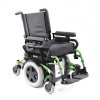I have a powered wheelchair that uses a specialised 24v Ni-Mh battery pack yamaha jwb2. Common on a lot of powered wheelchairs.
The battery pack no-longer holds any charge and it will cost over $1500.00 New Zealand to replace.
I am going to replace it with 2 x 12v 6.7Ah SLA batteries but, as the Ni-Mh fits into a dedicated slot in the wheelchair, I going to rip the guts out of the Ni-Mh battery case and wire the SLA's into the output circuit.
My only issue and the one that I need advice on is:
The electronic joystick control is powered by 4.7v taped internally in the 24v Ni-Mh battery case.
I intend to use a 12v to 5v USB power supply for the joystick circuit.
I don't think that an extra 0.3 of a volt will be an issue but I do need advice, because if I fry the joystick electronics then my chair is useless.
WILL 5V destroy the joystick circuit.
I have already mocked the circuit and given it a trial run using the 2 x 12v 6.7Ah SLA's
and using 3 x 1.2v rechargeable AA cells to power the Joystick.
The AA cells only last about 5 minutes.
Thanks in advance.
The battery pack no-longer holds any charge and it will cost over $1500.00 New Zealand to replace.
I am going to replace it with 2 x 12v 6.7Ah SLA batteries but, as the Ni-Mh fits into a dedicated slot in the wheelchair, I going to rip the guts out of the Ni-Mh battery case and wire the SLA's into the output circuit.
My only issue and the one that I need advice on is:
The electronic joystick control is powered by 4.7v taped internally in the 24v Ni-Mh battery case.
I intend to use a 12v to 5v USB power supply for the joystick circuit.
I don't think that an extra 0.3 of a volt will be an issue but I do need advice, because if I fry the joystick electronics then my chair is useless.
WILL 5V destroy the joystick circuit.
I have already mocked the circuit and given it a trial run using the 2 x 12v 6.7Ah SLA's
and using 3 x 1.2v rechargeable AA cells to power the Joystick.
The AA cells only last about 5 minutes.
Thanks in advance.
Last edited:



